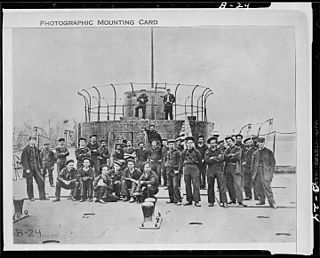
William Longshaw Jr. was a physician who volunteered for service in the United States Union Navy during the American Civil War. Longshaw obtained medical and pharmacy training in Boston, New York City, and New Orleans, receiving his medical degree from the University of Michigan. He was appointed acting assistant surgeon by the navy in 1862, serving aboard USS Yankee, Passaic, Penobscot, Lehigh, and finally his squadron's flagship Minnesota.

The first USS Lehigh was a Passaic-class monitor launched 17 January 1863 by Reaney, Son & Archbold, Chester, Pennsylvania, under a subcontract from John Ericsson; and commissioned at Philadelphia Navy Yard 15 April 1863, Commander John Guest in command.

The City-class ironclad USS Cincinnati was a stern-wheel casemate gunboat in the United States Navy during the American Civil War. She was named for Cincinnati, Ohio, and was the first ship to bear that name in the United States Navy.

Thomas E. Corcoran was a Union Navy sailor in the American Civil War and a recipient of the United States military's highest decoration, the Medal of Honor, for his actions during the Siege of Vicksburg. He was awarded the medal for rescuing his crewmates during the sinking of his ship, the USS Cincinnati, in the Mississippi River. Under heavy fire from a Confederate artillery battery, Corcoran and three other men swam back and forth between the riverbank and the sinking ship, helping crewmen who could not swim reach shore. The four men then towed a small boat, carrying wounded sailors and the ship's commander, to the safety of Union forces.
Wilson Brown was a Union Navy sailor during the American Civil War and a recipient of America's highest military decoration, the Medal of Honor.
Michael Connelly was a United States Navy sailor and a Medal of Honor recipient for his role in the American Civil War. He served under the name John Mack.
John S. Lanning was a Union Navy sailor and a Medal of Honor recipient for his actions in the American Civil War. He served under the name John S. Lann.
George W. Leland was a Union Navy sailor in the American Civil War and a recipient of the U.S. military's highest decoration, the Medal of Honor, for helping to free his grounded ship.
Thomas Jenkins was a Union Navy sailor in the American Civil War and a recipient of the United States military's highest decoration, the Medal of Honor, for his actions during the Siege of Vicksburg. He was awarded the medal for rescuing his crewmates during the sinking of his ship, the USS Cincinnati, in the Mississippi River. Under heavy fire from a Confederate artillery battery, Jenkins and three other men swam back and forth between the riverbank and the sinking ship, helping crewmen who could not swim reach shore. The four men then towed a small boat, carrying wounded sailors and the ship's commander, to the safety of Union forces.

Gurdon H. Barter was a U.S. sailor stationed aboard the USS Minnesota during the American Civil War. He received the Medal of Honor for his actions during the Second Battle of Fort Fisher on January 15, 1865.

Henry S. Webster was a sailor in the U.S. Navy stationed aboard the USS Susquehanna (1850) during the American Civil War. He received the Medal of Honor for his actions during the Second Battle of Fort Fisher on January 15, 1865.
Charles Read was a Union Navy sailor in the American Civil War and a recipient of the U.S. military's highest decoration, the Medal of Honor, for his actions at the Battle of Natural Bridge.
George Pyne was a Union Navy sailor in the American Civil War and a recipient of the U.S. military's highest decoration, the Medal of Honor, for his actions at the Battle of Natural Bridge.
George Schutt was a Union Navy sailor in the American Civil War and a recipient of the U.S. military's highest decoration, the Medal of Honor, for his actions at the Battle of Natural Bridge.

Frank S. Gile was a Union Navy sailor in the American Civil War and a recipient of the U.S. military's highest decoration, the Medal of Honor, for helping to free his grounded ship.

William Williams was a Union Navy sailor in the American Civil War and a recipient of the U.S. military's highest decoration, the Medal of Honor, for helping to free his grounded ship.
Daniel Noble (1838–1903) was a Confederate prisoner at Camp Douglas before becoming a Union Navy sailor in the American Civil War and a recipient of the U.S. military's highest decoration, the Medal of Honor, for his actions at the Battle of Mobile Bay.
Thomas Irving was a Union Navy sailor in the American Civil War and a recipient of the U.S. military's highest decoration, the Medal of Honor, for helping to free his grounded ship.

James Brown was an officer in the United States Navy who served as quartermaster aboard the USS Albatross during the American Civil War. He received his nation's highest award for bravery during combat, the U.S. Medal of Honor, for his actions aboard ship during the Union Navy's May 4, 1863 attack on Fort DeRussy in an attempt to disrupt the hold by Confederates over the Red River region of Louisiana. That award was conferred on April 16, 1864.
Daniel C. Harrington was a Union Navy sailor in the American Civil War who received the U.S. military's highest decoration, the Medal of Honor.






